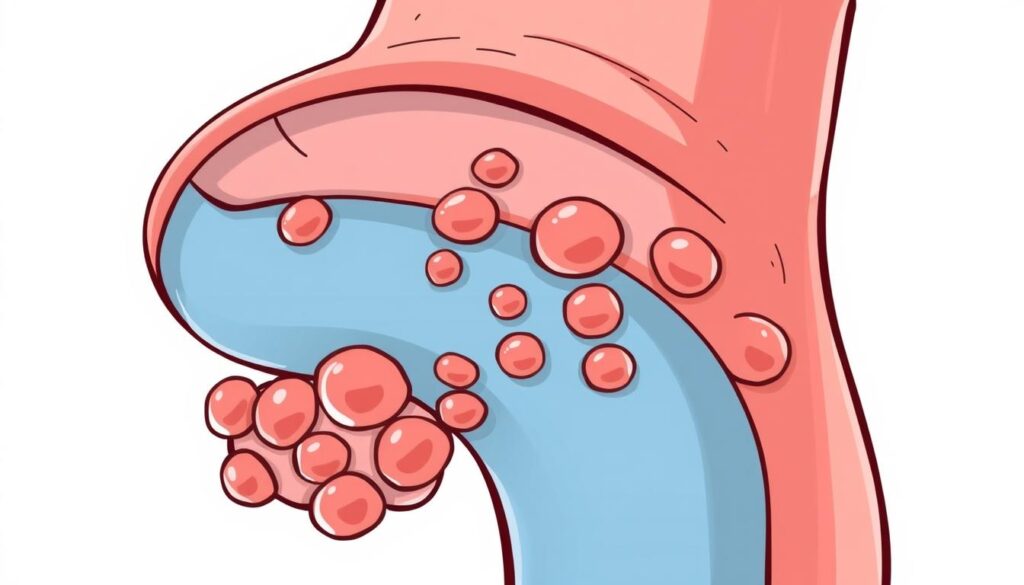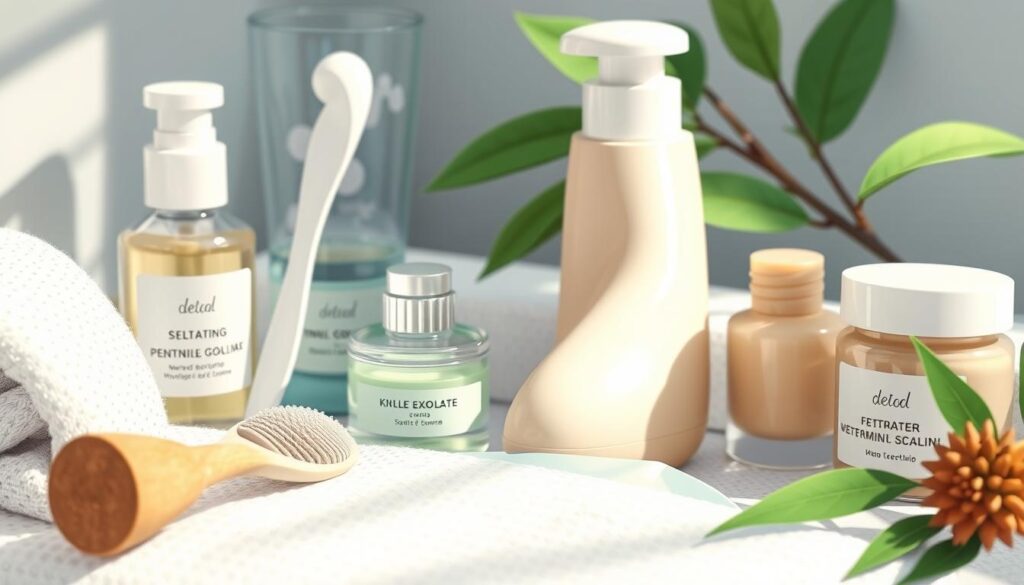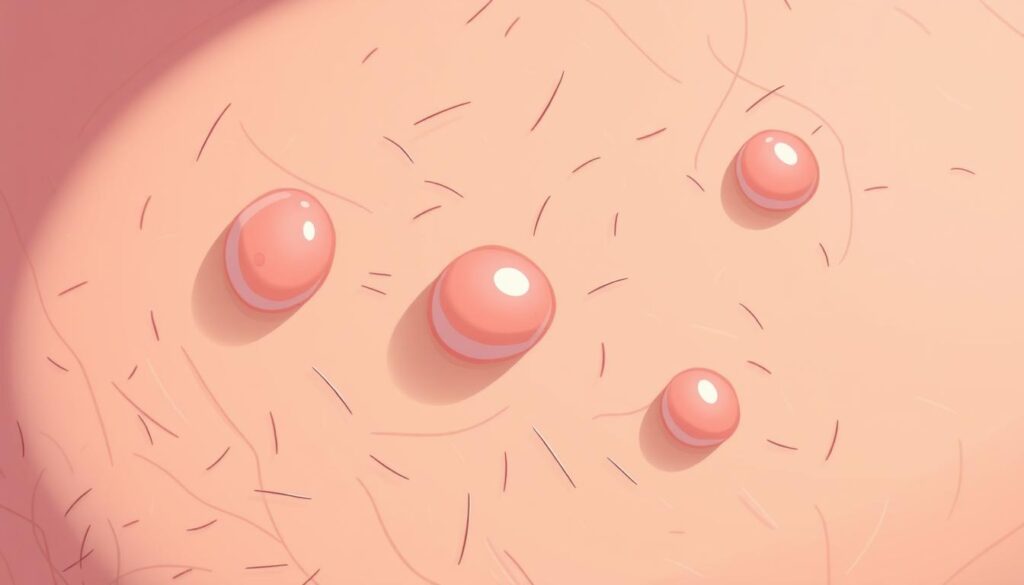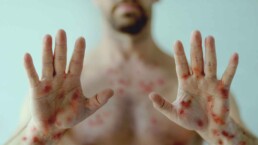Ingrown hairs are common, especially in areas you shave or wax. This includes the pubic region and the penis shaft. These bumps, also known as “razor bumps,” can be itchy, painful, and look bad.
Table of Contents
ToggleBut, there’s hope. With the right steps, you can treat and stop ingrown hair bumps on your penis shaft. Dr. Good Deed, a top expert in men’s health, will show you how. He’ll share his best ways to get rid of these annoying ingrown hairs for good.
What are Ingrown Hair Bumps on the Penile Shaft?
Ingrown hairs on the penis look like small, red bumps. They might be filled with clear or yellowish liquid. These bumps can be itchy, sore, and have a dark hair in the middle.
Symptoms and Causes
Ingrown hairs happen when a hair curls back into the skin or hair follicle. This can be due to bad shaving, shaving too much, or having thick hair. It leads to irritation and bumps on the penis.

Not all bumps on the penis are from ingrown hairs. Other things like pimples, papules, razor burn, and infections can also cause bumps. If you’re not sure, see a doctor for help.
Identifying Ingrown Hair Bumps on the Penile Shaft
Ingrown hairs on the penile shaft look like small, red bumps. They can be itchy, irritated, and painful. It’s key to tell them apart from other bumps, like pimples or cysts.
These bumps might look like allergic reactions or pearly penile papules. They could also be from tight clothes or infections like molluscum contagiosum. Genital herpes and HPV are other possible causes.
Recent studies show up to 20% of men have pearly penile papules. These are often mistaken for warts. Angiokeratomas, skin tags, and folliculitis can also cause bumps.
If you’re not sure about the bumps, see a doctor. They can check the bumps, do tests, and tell you what they are. This way, you get the right treatment for your problem.

Ingrown hairs are common, but other issues can also cause bumps. If the bumps don’t go away or hurt, get medical help. A doctor can help you figure out what’s going on and fix it.
At-Home Treatment for Penile Shaft Ingrown Hairs
Dealing with ingrown hairs on your penile shaft can be annoying. But, there are ways to treat them at home. Most ingrown hairs will heal on their own. Yet, if they get infected or swollen, you need to act fast to avoid more problems.
Start by using a warm compress on the area. The warmth helps the ingrown hair come out of the follicle. This makes it easier to treat. Do this a few times a day for 10-15 minutes each time.
Using an anti-acne product with salicylic acid or benzoyl peroxide can also help. Clean the area gently and apply a thin layer of the product as instructed.
- If you see a bump, try to drain it with a sterile pin or tweezers. Be very gentle to avoid breaking the skin and causing more irritation or infection.
- After draining, apply an antibacterial ointment or a bit of tea tree oil to prevent infection.
- Using a hydrocortisone cream can also help with itching or discomfort from the ingrown hair.
If the ingrown hair doesn’t get better in a few days or shows signs of infection, see a healthcare provider. With the right care at home, you can manage those pesky ingrown hairs on your penile shaft.

Ingrown Hair Bumps on the Penile Shaft? Dr. Good Deed’s Guide to Getting Rid of Them.
Ingrown hair bumps on the penile shaft can be uncomfortable and frustrating. But, with the right approach, you can find relief. Dr. Good Deed, a renowned dermatologist, has expert advice to help you tackle this problem effectively.
For mild cases, Dr. Good Deed suggests at-home treatments. Start by applying warm compresses to the affected area. This can help soften the skin and release the ingrown hair. You can also use over-the-counter anti-acne products with benzoyl peroxide or salicylic acid. These can reduce inflammation and prevent infection.
If the bumps become infected or don’t improve with home remedies, seek medical attention. Dr. Good Deed may prescribe topical steroids or retinoids to reduce inflammation. Or, antibiotics to treat any infection. In some cases, a minor in-office procedure may be needed to extract the ingrown hair.
Prevention is key to avoid future ingrown hair bumps. Dr. Good Deed stresses the importance of proper hair removal techniques. Gently exfoliate the area before and after shaving, use a clean, sharp razor, and avoid tight-fitting clothing.
If you have concerns or the bumps persist, don’t hesitate to consult Dr. Good Deed or another healthcare professional. With the right treatment and preventive measures, you can get rid of those pesky ingrown hair bumps and regain your comfort.

Preventing Ingrown Hairs on the Penile Shaft
Proper Hair Removal Techniques
To avoid ingrown hairs on your penile shaft, start with the right hair removal methods. Try to shave or wax less often. When you do, use the correct technique.
First, use a new, sharp razor blade. Shave in the hair growth direction. Don’t shave too close to your skin. A gentle shaving cream or gel can help prevent irritation. Regular exfoliation keeps pores open and reduces dead skin buildup.
- Use a sharp, fresh razor blade
- Shave in the direction of hair growth
- Avoid shaving too closely to the skin
- Apply a gentle, lubricating shaving cream or gel
- Exfoliate the area regularly
Choosing electrolysis or laser hair removal can also prevent ingrown hairs. Wearing loose clothes and keeping the area moisturized also helps.
By following these tips, you can keep ingrown hairs away. This helps keep your penile area healthy and comfortable.
When to Seek Medical Attention
Most ingrown hairs on the penile shaft can be treated at home. But, if the area gets very infected or hurts a lot, you should see a doctor. Look out for signs like more redness, warmth, swelling, pus, and a lot of pain.
If you see these signs, go see your doctor or a dermatologist. They can figure out what’s wrong and fix it. They might give you creams or pills, or even need to remove the hair with a needle.
Going to the doctor is key to stop the infection from getting worse. Not treating an infected ingrown hair can lead to bigger problems. So, if you’re worried, don’t wait to talk to a healthcare expert.
It’s always safer to be careful with your health. If you’re not sure if you need to see a doctor, it’s best to ask. Your health is important, and your penis’s health is no exception.
Complications of Untreated Ingrown Hairs
Not treating ingrown hairs on the penile shaft can cause big problems. Severe infections can lead to painful and large boils or swollen lymph nodes. Also, untreated infections might cause dark or raised scars in the pubic and groin area.
Ingrown hairs can also cause a staph infection called pseudofolliculitis barbae, or “barber’s itch.” This is more common in people with coarser, curlier hair. It can cause inflammation, irritation, and even permanent scarring if not treated.
It’s very important to see a doctor quickly to avoid these serious problems. Ignoring ingrown hairs can make symptoms worse, increase the risk of infection, and cause long-term damage.
Some common problems from untreated ingrown hairs on the penile shaft include:
- Severe infections leading to painful boils or swollen lymph nodes
- Permanent scarring and discoloration in the pubic and groin area
- Staph infection (pseudofolliculitis barbae) causing inflammation and irritation
Dealing with ingrown hairs quickly can stop these problems and reduce long-term damage. Always get professional medical advice for the best treatment and to avoid more issues.
Conclusion
Ingrown hair bumps on the penile shaft can be uncomfortable. If not treated, they might cause bigger problems. Dr. Good Deed’s advice can help you manage and prevent these issues.
Don’t remove too much hair. Use the right methods when shaving or waxing. If the area gets infected or very sore, see a doctor.
Knowing how to spot ingrown hair bumps is key. Use home care tips and get medical help when needed. This way, you can avoid ingrown hairs and keep your genital area healthy.
Stay alert and talk to a healthcare provider if you’re worried about your intimate area. Following this article’s advice can help you control ingrown hair bumps. This will make you feel more comfortable and confident.
Take care of your genital health. Don’t let ingrown hair bumps ruin your day. With the right steps and medical help, you can keep your penile shaft smooth and healthy.
FAQ
What are the symptoms of ingrown hair bumps on the penile shaft?
Ingrown hairs on the penile shaft look like small, red bumps. They are filled with pus and can be itchy and painful.
What causes ingrown hairs on the penile shaft?
Ingrown hairs happen when a hair curls back into the skin. This can be due to bad shaving, shaving too much, or having thick hair.
How can I identify ingrown hair bumps on the penile shaft?
Look for small, red bumps with pus. They might have visible hair at the center. If unsure, see a doctor.
What are the recommended at-home treatments for ingrown hairs on the penile shaft?
Use a warm compress and anti-acne products. Gently drain the bump and treat with antibacterial ointment or tea tree oil.
When should I seek medical attention for ingrown hairs on the penile shaft?
See a doctor if the bumps get worse. Look for signs like more redness, swelling, and pus. Your doctor can help with infections.
What are the potential complications of untreated ingrown hairs on the penile shaft?
Untreated ingrown hairs can cause big, painful boils and swollen lymph nodes. They can also leave dark scars and increase the risk of infection.
How can I prevent ingrown hairs on the penile shaft?
Avoid shaving or waxing as much as you can. Use a fresh razor and shave in the hair’s direction. Keep the area clean and exfoliated.
Source Links

This article is medically reviewed by Dr. Chandril Chugh, Board-Certified Neurologist, providing expert insights and reliable health information.
Dr. Chandril Chugh is a U.S.-trained neurologist with over a decade of experience. Known for his compassionate care, he specializes in treating neurological conditions such as migraines, epilepsy, and Parkinson’s disease. Dr. Chugh is highly regarded for his patient-centered approach and dedication to providing personalized care.








